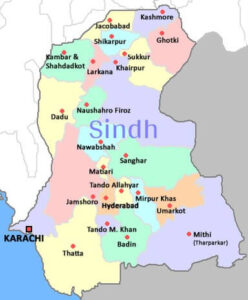 Introduction
Introduction
Discover the vibrant history of Sindh, a province in Pakistan with a rich cultural heritage dating back to 7000 BCE. Home to the Sindhi people, an Indo-Aryan ethnic group, and blessed with the fertile lands of the Indus River, Sindh has witnessed the rise and fall of ancient civilizations and the influence of various empires.
This article explores the historical journey of Sindh, from its roots in the Vedic civilization to the diverse cultural landscape it boasts today.
Ancient Roots: Vedic Civilization and Beyond
Around 1500 BC, the Sindhis played a pivotal role in founding the Vedic civilization between the sacred rivers Saraswati and Ganges, influencing the development of cultures across South Asia. Sindh flourished as a predominantly Hindu and Buddhist region until 720 AD, when it embraced Islam under Arab rule. The Arab, Persian, and Turkish settlers left an indelible mark on Sindh, making it a crucial gateway into India.
Dynastic Transitions: Soomra, Samma, and Arghun
The Soomra dynasty, descendants of the Rajput tribe, ruled Sindh from 1011 AD to 1333 AD, leaving a lasting impact on Sindhi culture. The Samma dynasty, with its roots in the Lohana tribe, seized control in 1333 AD, expanding its rule over Sindh, parts of Kutch, Punjab, and Balochistan until 1520 AD. The Arghun dynasty, of Mongol and Turk-Mongol descent, followed, ruling from 1520 AD to 1554 AD, succeeded by the Tarkhan branch until 1591 AD.
Colonial Era: British Influence and Hindu Sindhi Migration
In 1843, the British arrived in Sindh as traders and strategically recognized it as a gateway to Afghanistan. After defeating the Talpurs in battles at Miani, Dubba, and Kunhera, the British took control, appointing Charles Napier as the first Governor of Sindh. The aftermath of the Partition of India in 1947 led to a significant migration of Hindu Sindhis to India and other parts of the world. Today, the Sindhi Hindu population in Pakistan has decreased to 1-3%, while in India, they form a vibrant community, particularly in the domains of business and culture.
Contemporary Diaspora: Flourishing Sindhi Community
Despite facing challenges during the Partition, Hindu Sindhis who migrated to India emerged as a prosperous and highly respected business community. With a population of around 2.77 million in India, the majority belong to the Amil and Bhaiband subcastes of the Lohana caste. Their journey from penniless migrants in 1947 to becoming a flourishing diaspora is a testament to their hard work, honesty, and commitment.
Conclusion
The history of Sindh is a captivating tale of ancient civilizations, dynastic transitions, and the resilience of its people. From the early Vedic period to the contemporary diaspora, Sindh has undergone significant transformations, contributing to the rich cultural tapestry of the region. In upcoming articles, we will delve into the challenges and triumphs of the Hindu Sindhi community over the past seven decades, showcasing their remarkable journey around the globe.

